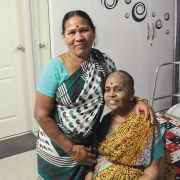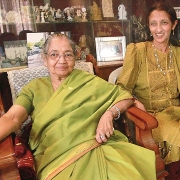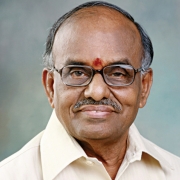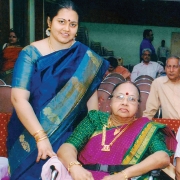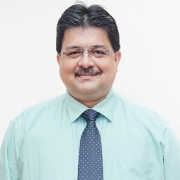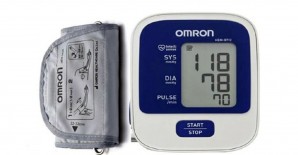
Health
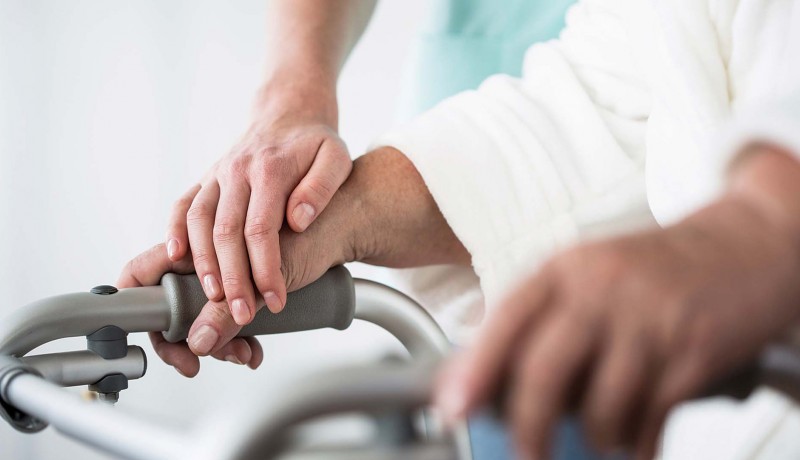
Driven by a silvering population, home-based healthcare in India is gaining ground. Though there are an increasing number of professional options available, better standards of service, cost-effectiveness and specialised care are the need of the hour, reports Ramya Srinivasan
It’s just another hurried morning in the Kumar household in Bengaluru. Praveena Suresh Kumar, 36, is juggling chores while getting her two daughters ready for school. Her husband Suresh Kumar is doing the morning email roundup on his Blackberry. Meanwhile, Suresh’s mother, Lakshmi Natarajan, who lives upstairs as part of the extended family, goes about her morning chores with the help of her aide, Saraswathi. Mrs Natarajan has acute rheumatoid arthritis and requires assistance to walk even a few steps.
“Saraswathi lives with us and has become a part of the family. She takes great care of my mother-in-law and looks after her daily needs. Given our hectic lives, it helps to have a dedicated person to look after her. Our daily routine would collapse if not for her,” shares Praveena, who was introduced to Saraswathi by a mutual friend.
Home-based elder care is fast becoming a necessity in many Indian households. And stepping in to fill this void, in the large metros at least, are home-care agencies whose numbers have witnessed a spurt in the past five years. In 2014, consulting firm Pacific Bridge Medical estimated the Indian home-care market to be around $ 2.3 billion, growing at 18 per cent per year.
The number crunch
This seemingly simple demand-supply scenario belies a complex and sobering reality—that India is a rapidly ageing population, something that will have serious ramifications only a few years down the line.
According to the State of Elderly in India report released in 2014 by non-profit HelpAge India, by 2050, the number of seniors will have risen to over 300 million, up from 98 million in 2011. This means that in just 34 years, one in five people, or 20 per cent of the Indian population, will be aged over 60, up from 9 per cent at present.
This tectonic demographic shift can be explained by many factors, the most significant one being that 65 per cent of India’s population is currently under the age of 35, a majority between the ages of 16 and 30. So while we revel in being a young and vibrant economy, it is this vibrant new India that will need senior care in the not-too-distant future.
Care wanted
There are many reasons that account for India’s ageing population. Dr V S Natarajan, a leading geriatrician from Chennai, points out that one of the main reasons is longevity. “Advances in medicine have extended the average age of humans,” he says. While this is good news, healthcare professionals point out that as people live longer, the elderly have to cope with chronic illnesses like arthritis, cardiac disease, respiratory problems and Alzheimer’s, which need constant monitoring and care.
Ageing brings physical and mental challenges that compromise independence, setting the stage for elder care. “Twenty years ago, I barely saw a dementia patient. But the number of such patients is shockingly higher today,” Natarajan reveals.
Another reason silvers are resorting to caretakers is the breakdown in the joint family system and the rise in nuclear families. A couple of decades ago, one would simply depend on a family member for home care and everyone was happy to pitch in. When someone fell ill, the women in the family were expected to step up and don the role of caretaker. More and more, women are now working and struggling to balance work and home, let alone care for a senior member of the family.
Sociologists point out that migration is another reason more silvers are living alone today. Increasingly, their children are moving far from home or overseas, making it impossible for them to provide physical and mental support to their ageing parents.
Praveena and Suresh Kumar, the couple from Bengaluru, decided to return after 15 years in the United States just to take care of their parents. However, a decision like this is never easy, what with so many logistical and financial factors to consider.
The Kumars typify what sociologists are calling the ‘sandwich generation’, young couples who are literally sandwiched between raising young children and caring for ageing parents. Having to manage their own personal and familial commitments, couples like these have little or no time to look after their parents. But there is one thing they have to potentially solve the problem: disposable incomes that allow them to outsource elder care.
There is another reason for the rising demand in caretaker services. Perceptions are changing. Unlike earlier, wealthy, urban silvers are now willing to spend their savings on home-care services.
Business is booming
Home-care service providers offer nursing attendants, nurses, doctor visits, physiotherapy and medical equipment. Some providers also have specialised offerings such as home cardiac care, pulmonology and oncology, palliative care and ICU services. However, the greatest demand, by far, is for nursing attendants during post-operative care. After surgery, elderly patients are not strong enough to take care of themselves and require focused care at home. Many require assistance with basic chores such as bathing, walking, grooming and eating, and being accompanied to the hospital for checkups. The services of nurses are availed only when significant medical intervention is needed and hiring a nursing aide is the most feasible option.
Another service slowly gaining popularity in metro cities is the ICU-at-home facility. “Compared to a hospital, such a facility works out much cheaper, between ₹ 3,000 and ₹ 7,000 per day, whereas in hospitals, it could be between ₹ 25,000 and ₹ 50,000 per day,” says Vivek Srivastava, CEO of Health Care At Home (HCAH). The fact that an increasing number of silvers are choosing home care is reflected in the astonishing increase in the numbers that typify this market. “We are expecting to see a 40-50 per cent increase in our compound annual growth rate in the next few years,” claims Srivastava. HCAH operates in areas including Punjab, Uttar Pradesh, Haryana, Rajasthan, Jammu, Shimla and Mumbai.
“Home healthcare in India is still at a nascent stage. With well over 80 per cent of business being catered to by the unorganised sector, there is still a long way to go. The last three years have been instrumental in creating awareness,” says T R Narayanaswamy, chief executive officer, One Life Home HealthCare, Chennai. “By 2020, the total Indian healthcare market is estimated to be pegged at $ 280 billion,” adds Srivastava. “Of this, the home-care segment will be around 3-6 per cent, a huge number.”
On ground, here’s what growth in the home-care segment looks like. In the past three years, Portea Medical expanded to 24 cities in India and four in Malaysia, with 4,000 staff handling 75,000 visits per month. One Life Home HealthCare, based in Chennai, has finished its first year with close to 8,000 service visits. Medwell Ventures acquired Bengaluru-based Nightingale Home Health Services to focus on home healthcare. Today, it covers 5,000 families in its annual care plans. India Home Health Care, based in Chennai, now operates in four cities. In addition, even hospital chains such as Max Healthcare and Columbia Asia offer homecare services.
While some agencies have a pan-India presence, others such as Homital Medcare and TriBeCa Care focus on niche cities.
So, all is well?
Although silvers and their families are spoilt for choice, hiring a caretaker for an elderly parent or relative has its pitfalls. As this is still an unorganised and unregulated market, there are no checks and balances in place.
Topping the list of concerns is safety and security. “A majority of our clients come to us after disappointing experiences with untrained staff and clinically mismanaged services from the unorganised sector,” says Narayanaswamy.
Mysuru resident Selma Pinto, 59, shares her bitter experience with an attendant from an agency. “We had a 19 year-old girl taking care of my 84 year-old mum. The girl was good at her work and we grew to trust her. Then, one day, I returned home to discover many valuables missing. I think I was more upset that she had left my mum alone.”
Privacy is another concern for families that hire caretakers. “The simple fact that there is someone present all the time makes it difficult to be normal in your own home. Even if you have a separate bedroom for the patient and the caretaker, it is still awkward,” says 38 year-old Uma Premanand, a homemaker in Mumbai, who hired a nursing aide in 2011 when her mother-in-law (late) Meenakshi Viswanathan suffered a hip fracture.
Things can get problematic if silvers are forced to switch caretakers when the previous one is no longer available. Agencies usually have a backup in place but the transition can be painful for the patient. “We had one lady who was extremely disciplined and would get my mother-in-law to do her physio exercises on time. After a while, she was replaced by another lady, who was very laidback. It is not easy to get accustomed to someone new,” says Premanand. Accountability is also low and quality of service varies considerably. Agencies point out that they have policies and procedures in place to train their personnel but, often, the services offered are inconsistent; the quality of service also depends on the skillset and commitment of the professional.
Everyday battle for the family
Although the silver undergoing home care is definitely at the centre of this story, there is another individual whose life is impacted: an immediate family member, usually the daughter or daughter-in-law, who endures maximum emotional impact.
“There was a time I used to go out and meet people but with mum’s health condition, someone has to stay at home in case of an emergency, and that’s usually me. Over time, I have become a homebody. It was difficult at first, but I have grown accustomed to it,” says Pinto.
Meanwhile, Suresh Kumar from Bengaluru reveals, “We were in the US for many years as a nuclear family. Then we shifted to India into a joint family setup. It was a major transition for all of us, especially for my wife, who looked after my mother all day. Next, we had to adjust to our personal space being shared by a hired caretaker.”
He adds, “My job involves a lot of travel; there were a couple of times when my mother had to be rushed to the emergency room and my wife had to handle this on her own. I watched her struggle physically and mentally, trying to adjust to her additional responsibilities. There were times I was worried that it would affect her health.”
In Premanand’s case, she had young children at home when her mother-in-law had the hip fracture. “Juggling kids’ activities, drops and pickups, and housework without upsetting my mother-in-law was very tough. Even though the attendant was there, she preferred me to be around.”
Dr Natarajan says that, at times, he is more worried for family members than the patients. The sudden change in routine, societal expectations, financial burden and lifestyle is very challenging for the family. “While most people start with dedication, showing enormous amount of love and care, they find it exhausting after a while. This is especially true of people with relatives suffering from disorders such as dementia. In such cases, the family member could be prone to depression and guilt, and may need counselling on how to deal with the situation.”
In some cases, the family member could be aged as well, and dealing with their own health issues. When 58 year-old Ramaa Lakshmi Narayanan from Chennai was a working woman, she depended on her mother-in-law Janaki Venkataraman to take care of her children and the household. Now, life has come full circle. Narayanan has diabetes and high blood pressure and is undergoing physiotherapy for pain in her knees. But she also takes care of her 92 year-old mother-in-law. “Although I have hired help, some days are particularly tough, given my health condition. If I fall sick, my husband has to take the day off from work or we need to find another way to work around the problem,” she says.
Although paid home-care services offer some relief to the family members, the financial burden can be enormous, especially for middle-class families. The cost of a full-time professional caretaker can range between ₹ 20,000 and ₹ 45,000 per month. In Tier-I cities, this service costs 10-15 per cent more than in Tier-II and III locations, while come-and-go services cost much more than live-in attendants. On the other hand, core nursing services cost 50 per cent more than aides do.
Some families have managed to successfully work out innovative methods to deal with these costs. When Janaki Venkataraman’s health demanded home care, her grandchildren quickly conferred on a WhatsApp group and decided to share the financial burden.
However, where pooling in resources to share the financial burden is not possible, some families make compromises such as hiring a caretaker only during the daytime and monitoring the patient in-house at night. Although a huge help, home care is also a bitter pill to swallow but one that many cannot avoid.
Emotional roller-coaster
Ageing is a challenging process for everyone. Not only is the body slowing down and changing, illness sets in for many, a reality that is hard to accept. Add to that the emotional issues associated with ageing.
Among the many challenges is the loss of independence, either partially or totally, for many silvers, as systems and organs begin to age. Chronic illnesses like arthritis, cardiac and pulmonary disease, stroke and partial paralysis, and weakness caused by the wages of silent killers like diabetes necessitate dedicated care.
While using the services of a caretaker may improve the lives of silvers and their families, it’s not as cut-and-dried as it seems. Making the transition from being an independent individual to leaning on hired help for the smallest of things can be emotionally crushing. Dr Natarajan remarks, “We may be doing well with physical treatment but are still lagging significantly on providing mental support.”
Janaki Venkataraman shares her story, “I was in my early 40s when I lost my husband. From a life of despair and financial struggle, I raised five children to be independent. Till even a few years ago, I managed all the household chores myself. But today, I can no longer do things with the same ease. My body has slowed.”
The younger generation may not realise it but what may seem like a minor adjustment could seem like a life change for the elderly. So even adjusting to a new caretaker is a challenging proposition for some. Lakshmi Natarajan, the mother-in-law from the Kumar family, explains, “Owing to my arthritis, I have been requiring help at home for the last couple of years. My biggest issue is when an existing caretaker leaves. It takes me a few weeks to adjust to the new person, and make her understand my dietary requirements and lifestyle preferences. As I spend a significant portion of my day with her, the emotional connect also matters. There was this one instance when a caretaker left in just two weeks, and it was really frustrating for me to adapt afresh.”
Dr Shaunak Ajinkya, consultant psychiatrist, Kokilaben Dhirubhai Ambani Hospital, Mumbai, emphasises the importance of counselling and focused geriatric services to deal with issues relating to silvers. This helps them accept their predicament and makes them feel less lonely. “In the West, it is a specialised field but in our country, the concept has drawn a blank.”
He adds, “Here, it is usually the local family physician that caters to the needs of older people. Not that physicians can’t look after older people, but as the body ages, it undergoes many changes and that’s what a geriatrician specialises in. Just the way you have paediatricians for children, you need to have geriatricians for older people.”
What does the future hold?
There is sufficient data to ring alarm bells among policymakers and the powers-that-be in government in India. But precious little has been done to address the fact that, in the blink of an eye, 20 per cent of Indians will be senior citizens.
That’s why a new initiative called the Longitudinal Ageing Study in India (LASI) is viewed as a positive step. Launched in March, the study will follow the health and socioeconomic conditions of 60,000 Indians over the age of 45 for at least 25 years and report on how growing old affects the country. Hopefully, this massive initiative, conducted under the aegis of the Ministry of Union Health and Family Welfare, means the Indian government is finally acknowledging that the dramatic demographic shift in India’s population means mounting pressure on socioeconomic fronts such as insurance systems and pension outlays, healthcare expenditure, fiscal discipline and savings levels. And that it will work to implement policy changes to address these challenges.
While India is waking up to this pressing reality rather late, developed countries such as the United Kingdom and Australia have already implemented strong restorative programs. The objective of these programmes is to provide short-term and timely home care for seniors and restore them to a state where they can be reasonably self-dependent.
As Prof S Siva Raju, chairperson of the Centre for Population, Health and Development, School of Development Studies, Tata Institute of Social Sciences (TISS), Mumbai, informs us, “Australia’s home-care services are offered free of charge for a few weeks for all assessed eligible clients. They are either referred at the community level for the Home Independence Program (HIP) or, following a hospital admission, for the Personal Enablement Program (PEP).” These are short-term, individualised programmes (eight to 12 weeks) that involve daily task analysis, work simplification and endurance building to restore the silver to a healthy and confident state.
Many countries also offer cash allowances for seniors. Italy, for example, has a cash-for-care scheme. Prof Siva Raju says, “In Germany, a combination of home care and residential services along with cash options is offered to the eligible elderly. The government is responsible for registering service providers, negotiating the price and overseeing the quality of services offered.”
Thanks to a strong familial system that has come to the rescue so far, India has lacked the fundamental recognition that the elderly need focused home healthcare. But times are changing—rapidly. And if one out of every five Indians is going to be a senior citizen in the next 30 years, it’s time to gear up, move towards a state of preparedness, and do right by Generation A.
TICKING THE RIGHT BOXES
How to identify the ideal home-care service agency for you
- Is the agency the right fit for the service you require? For example, some agencies may have nursing aide services but may not support doctor visits or supply medical equipment. Some have nursing services but not palliative care. Make a comprehensive list of the services you require and ensure that the agency matches your needs.
- Is the agency the right price fit for you? If not, evaluate alternatives. Perhaps you can consider a piecemeal approach by using the services of your family doctor for home visits and the agency for specific services (physiotherapy, nursing, etc) you need.
- Does the agency have a good reputation? Do your fundamental research on the Internet and through word of mouth.
- Does the agency provide the right technology support? If the silver lives alone, with the family in a different location, technology enablement can matter, as it helps remotely track the health of the patient.
- Be aware of your rights—talk to the agency to understand their policies and procedures, the background checks they conduct on their personnel and the backup systems in place in case your primary caretaker is unavailable for the day.
- If you are not satisfied with the service, do not hesitate to ask for a replacement. Compatibility between the patient and the caretaker can expedite the recovery process.
THE WAY FORWARD
Recommendations of Prof S Siva Raju, TISS, to improve home care in India
- Make geriatric healthcare a part of primary healthcare services
- Train peripheral health workers and community health volunteers to identify and refer elderly patients for timely treatment
- Provide specialised training for medical officers in geriatric medicine
- Supply elderly patients from poor and low-income facilities with free or reasonably priced treatment through public-private partnership
- Use day-care hospitals to play an important role in providing close supervision and follow-up of patients with chronic diseases (cost of a day-care centre is less than a nursing home)
- Use NGOs, charitable organisations and faith-based organisations to play a key role
- Regulate home-care services to promote ageing in place
THE COSTS OF CARE
The typical costs involved in availing the service of home-care agencies
| Type of service | Costs (approximate figures, varies across agencies) |
| Preventive care (doctor visits and lab tests) | One-time visit: ₹ 800-1,700 Annual: ₹ 12,000-25,000 |
| Nursing service visits | One-time visit: ₹ 250-1,000 |
| Long-term nursing | 12-hour care, monthly: ₹ 20,000-30,000 24-hour care, monthly: ₹ 30,000-45,000 |
| Nursing attendant | 24-hour care, monthly: ₹ 20,000-36,000 |
| Total knee replacement aftercare and other physiotherapy treatments | One session: ₹ 450-850 |
| Diabetes care plan | Annual: ₹ 15,000 |
| Holistic eldercare (nursing attendant, physiotherapy services, ancillary services such as lab tests and medical equipment rental, complimentary doctor visits) |
Monthly: ₹ 19,000-40,000 |
| ICU at home | Per day: ₹ 3,000-7,000 |
HELP AT HAND
| HCAH | https://www.healthcareathomeindia.com/ | 1800 102 4224 |
| Portea | https://www.portea.com/ | 1800 121 2323 |
| Nightingales | https://www.nightingales.in/ | Bengaluru: 1800 103 4530 Hyderabad: 040-40020001 Mumbai: 022-22847777 |
| India Home
Health Care |
https://www.indiahomehealthcare.com/ | Chennai: 044-43594456 North Bengaluru: 080-4092 3923 South Bengaluru: 080-41714100 Pune: 020-40042000 Hyderabad: 040-40119600 |
| One Life Home HealthCare | https://www.onelifehealthcare.in/ | +91 97903 33411 |
| Homital Medcare | https://www.homital.in/ | +91 84471 84471 |
| TriBeCa Care | https://www.tribecacare.com/ | 033 40277777 |
Photo: iStock Featured in Harmony — Celebrate Age Magazine May 2016
you may also like to read
-
Hot tea!
If you enjoy sipping on that steaming hot cup of tea, think twice. New research establishes a link between drinking….
-
Weight and watch
If you have stayed away from lifting weights at the gym, thinking it might not be a good idea for….
-
Toothy truth
Research has established a clear association between cognitive function and tooth loss when cognitive function score was categorised into quintiles…..
-
PRODUCT OF THE MONTH
Automatic Blood Pressure Monitor Measure your blood pressure and pulse rate with no fuss Hypertension, or high blood pressure, could….



